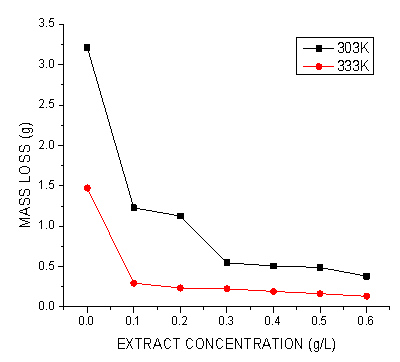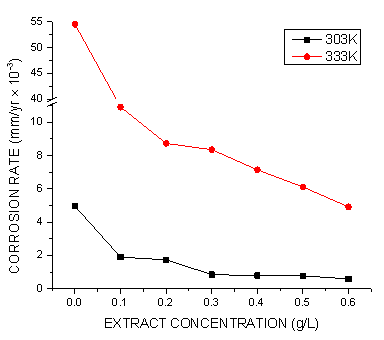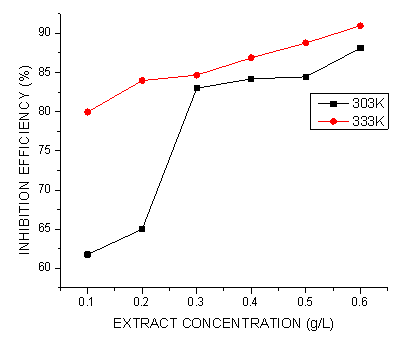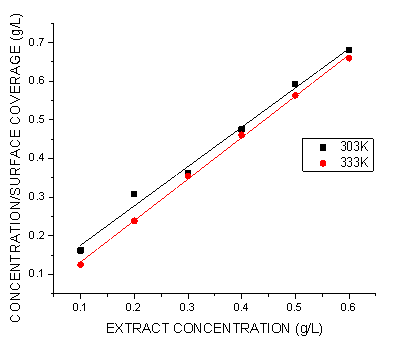| [1] | A. Henschel, I. Senkovska, S. Kaskel (2011), Liquid-phase adsorption on metal-organic frameworks. Adsorption, 17: 219–226. |
| [2] | R. N. Kuklin and V. V. Emets (2014), Physicochemical Processes at the Interfaces: Form Factor of the Electron Density of an Anion Specifically Adsorbed on Metal Surface in an Electrolyte, Protection of Metals and Physical Chemistry of Surfaces, 50(1), 5–14. |
| [3] | A. N. Frumkin (1982), Potentsialynulevogozaryada (Potentials of Zero Charge), Moscow: Nauka. |
| [4] | P. B. Raja, M. G, Sethuraman (2010), Studies of Inhibition of Mild Steel Corrosion by Rauvolfia serpentine in Acid Media, J. Mat. Engr. Perf., 19: 761-766. |
| [5] | L. Li, X. Zhang, J. Lei, J. He, S. Zhang, and F. Pan (2012), Adsorption and Corrosion Inhibition of Osmanthus fragran Leaves Extract on Carbon Steel, Corros. Sci., 63:82–90. |
| [6] | P. B. Raja, A. K. Qureshi, A. A. Rahim, K. Awang, M. R. Mukhtar, H. Osman (2013), Indole Alkaloids of Alstoniaangustifolia var. latifolia as Green Inhibitor for Mild Steel Corrosion in 1 M HCl Media, J. Mat. Engr. Perf, 22: 1072-1078. |
| [7] | A. Popova, M. Christov, S. Raicheva, and E. Sokolava (2004), Adsorption and Inhibitive Properties of Benzimidazole Derivatives in Acid Mild Steel Corrosion, Corros. Sci., 46: 1333–1350. |
| [8] | A. Ahamad, M. A. Quraishi (2009), Bis (benzimidazol-2-yl) disulphide: An efficient water soluble inhibitor for corrosion of mild steel in acid media, Corros. Sci., 51:2006-2013. |
| [9] | S. K. Shukla, M. A. Quraishi (2009), 4-Substituted anilinomethylpropionate: New and efficient corrosion inhibitors for mild steel in hydrochloric acid solution, Corros. Sci., 51:1990-1997. |
| [10] | A.K. Singh, M.A. Quraishi (2009), Effect of 2,2′ benzothiazolyl disulfide on the corrosion of mild steel in acid media, Corros. Sci., 51: 2752-2760. |
| [11] | S. M. A. Hosseini, A. Azimi (2009), The inhibition of mild steel corrosion in acidic medium by 1-methyl-3- pyridin-2-yl-thiourea, Corros. Sci., 51: 728-732. |
| [12] | A. Ahamad and M. A. Quraishi (2010), Mebendazole: New and Efficient Corrosion Inhibitor for Mild Steel in Acid Medium, Corros. Sci., 52: 651–656. |
| [13] | A. K. Singh and M. A. Quraishi (2010), Effect of Cefazolin on the Corrosion of Mild Steel in HCl Solution, Corros. Sci., 52: 152–160. |
| [14] | P. Muthukrishnan, B. Jeyaprabha, and P. Prakash (2013), Corrosion Inhibition and Adsorption Behavior of Setaria verticillata Leaf Extract in 1M Sulphuric Acid, J. Mat. Engr. Perf., 22: 3792-3800. |
| [15] | Oguzie, E. E., Enenebeaku, C. K., Akalezi, C. O., Okoro, S. C., Ayuk, A. A., Ejike, E. N. 2010. Adsorption and corrosion- inhibiting effect of Dacryodisedulis extract on low carbon-steel corrosion in acidic media, Int. J. Colloid Interf. Sci., 34: 283-292. |
| [16] | M. Lebrini, F. Robert, A. Lecante, and C. Ross (2011), Corrosion Inhibition of C38 Steel in 1M Hydrochloric Acid Medium by Alkaloids Extract from, Intl. J. Biochem Sc., 6: 2443–2460. |
| [17] | P. C. Okafor, M. I. Ikpi, I. E. Uwah, E. E. Ebenso, U. J. Ekpe, and S. A. Umoren (2008), Inhibitory Action of Phyllanthusamarus Extract on the Corrosion of Mild Steel in Acidic Media, Corros. Sci., 50: 2310–2317. |
| [18] | A.Y. El-Etre (2007), Inhibition of Acid Corrosion of Carbon Steel Using Aqueous Extract of Olive Leaves, J. Colloid Interface Sci., 314:578–583. |
| [19] | A. Lecante, F. Robert, P.A. Blandinieres, and C. Roos (2011), Anti-Corrosive Properties of S. tinctoria and G. ouregou Alkaloid Extracts on Low Carbon Steel, Curr. Appl. phys., 11: 714–724. |
| [20] | A. K. Satapathy, G. Gunasekaran, S. C. Sahoo, K. Amit, P. V. Rodrigues (2009), Corrosion Inhibition by Justica gendarussa Plant Extract in Hydrochloric Acid Solution, Corros. Sci., 51: 2848–2856. |
| [21] | E. E. Oguzie (2008), Evaluation of the Inhibitive Effect of Some Plant Extracts on the Acid Corrosion of Mild Steel, Corros. Sci., 50: 2993–2998. |
| [22] | U. M. Eduok, S. A. Umoren, A. P. Udoh (2012), Synergistic inhibition effects between leaves and stem extracts of Sidaacuta and iodide ion for mild steel corrosion in 1 M H2SO4 solutions, Arabian Journal of Chemistry, 5(3): 325-337. |
| [23] | A. Hamdy, N. S. El-Glendy (2013), Thermodynamic, adsorption and electrochemical studies for corrosion inhibition of carbon steel by henna extract in acid medium, Egyptian Journal of Petroleum, 22(1):17-25. |
| [24] | I. E. Uwah, P. C. Okafor, V. E. Ebiekpe (2013), Inhibitive action of ethanol extracts from Nauclealatifolia on the corrosion of mild steel in H2SO4 solutions and their adsorption characteristics, Arabian Journal of Chemistry, 6(3):285-293. |
| [25] | A. El Bribri, M. Tabyaoui, B. Tabyaoui, H. El Attari, F. Bentiss (2013), The use of Euphorbia falcata extract as eco-friendly corrosion inhibitor of carbon steel in hydrochloric acid solution, Materials Chemistry and Physics, 141(1): 240-247. |
| [26] | K. Tebbji, A. Aouniti, A. Attayibat (2011), Inhibition efficiency of two bipyrazole derivatives on steel corrosion in hydrochloric acid media, Indian Journal of Chemical Technology, 18: 244–253. |
| [27] | A. Nahl´e, I. Abu-Abdoun, and I. Abdel-Rahman (2007), Electrochemical studies of the effect of trans-4- hydroxy-4’-stilbazoleon the corrosion inhibition of mild steel in HCl solution, Anti-Corrosion Methods and Materials, 54(4):244–248. |
| [28] | S. M. Beloglazov, Z. I. Dzhafarov, V. N. Polyakov, and N. N. Demushia (1991), Quaternary ammonium salts as corrosion inhibitors of steel in the presence of sulfate-reducing bacteria, Protection of Metals USSR, 27(6): 810–813, 1991. |
| [29] | A. V. Fokin, M. V. Pospelov, and A. N. Levichev (1983), Structural and protective capacities of organic corrosion inhibitors: 2-Alkylethylenediamines and quaternary ammonium salts, Protection of Metals USSR, 19(2): 242–244. |
| [30] | A. H. Nahl´e (1997), Electrochemical studies of corrosion inhibition of a series of quaternary ammonium salts on iron in HCl solution,” Corrosion Prevention and Control, 44(4): 99–105. |
| [31] | A. H.Nahl´e (1998), Inhibition of iron in HCl using benzyl trimethylandtriethyl-ammonium chlorides, Corrosion Prevention and Control, 45(4):124–130. |
| [32] | A. Nahle (2002), Effect of triethanolamine on the electrochemical dissolution of solder in NaOH solution, Bulletin of Electrochemistry, 18(3):105–110. |
| [33] | A. Nahl´e and F. C.Walsh (1995), Electrochemical studies of two corrosion inhibitors for iron in HCl: cetyltrimethyl ammonium bromide and tetraphenyl phosphonium chloride, Corrosion Prevention and Control, 42(2):30–34. |
| [34] | B. V. Savithri and S. M. Mayanna (1996), Tetrabutyl ammonium iodide, cetylpyridinium bromide and cetyltrimethyl ammonium bromide as corrosion inhibitors for mild steel in sulphuric acid, Indian Journal of Chemical Technology, 3(5):256–258. |
| [35] | T. Vasudevan, S. Muralidharan, S. Alwarappan, and S. V. K.Iyer, “The influence of N-hexadecyl benzyl dimethyl ammoniumchloride on the corrosion of mild steel in acids,” Corrosion Science, vol. 37, no. 8, pp. 1235–1244, 1995. |
| [36] | S. Muralidharan, K. L. N. Phani, S. Pitchumani, S. Ravichandran, S. V. K. Iyer (1995), Polyamino- benzoquinone polymers: a new class of corrosion inhibitors for mild steel, Journal of the Electrochemical Society, 142(5):1478–1483. |
| [37] | J. D. Talati, M. N. Desai, and N. K. Shah (2005), Meta-Substitute daniline-N-salicylidenes as corrosion inhibitors of zinc in sulphuric acid, Materials Chemistry and Physics, 93:54–64. |
| [38] | T. T¨uken, B. Yazici, and M. Erbil (2002), The effect of nicotinamide on iron corrosion in chloride solutions, Turkish Journal of Chemistry, 26(5):735–742. |
| [39] | A. A. Fattah, E. M. Mabrouk, R. M. Elgalil, M. M. Ghoneim (1991), N-heterocyclic compounds as corrosion inhibitors for Zn in HCl acid solutions, Bulletin de la Societ´e Chimique de France, 1:48–53. |
| [40] | S. L. Granese, B. M. Rosales, C. Oviedo, and J. O. Zerbino (1992), The inhibition action of heterocyclic nitrogen organic compounds on Fe and steel in HCl media, Corrosion Science, 33(9):1439–1453. |
| [41] | H. A. Al-Lohedan, E. Khamis, and Z. A. Issa (1996), Studies on the influence of temperature on the adsorption of some cationic surfactants on to steel, Adsorption Science and Technology, 13(3):137–152. |
| [42] | L. G. Qiu, A. J. Xie, and Y. H. Shen (2005), A novel triazole-based cationic gemini surfactant: synthesis and effect on corrosion inhibition of carbon steel in hydrochloric acid, Materials Chemistry and Physics, 91(2-3):269–273. |
| [43] | A. Nahl´e, I. Abu-Abdoun, and I. Abdel-Rahman (2007), Electrochemical studies of the effect of trans-4-hydroxy-4’-stilbazoleon the corrosion inhibition of mild steel in HCl solution, Anti-Corrosion Methods and Materials, 54(4):244–248. |
| [44] | A. Nahl´e, I. Abu-Abdoun, and I. Abdel-Rahman (2007), Corrosion Inhibition by (Anthraquinone-2-ylmethyl) triphenylphosphonium bromide, Bulletin of Electrochemistry, 23:201–209. |
| [45] | A. Nahl´e, I. Abu-Abdoun, and I. Abdel-Rahman (2003), Inhibition of carbon steel corrosion by 4-vinylbenzyl triphenylphosphonium chloride in HCl solution, Anti-Corrosion Methods and Materials, 55(4):217–224. |
| [46] | A. Popova, M. Christov, and T. Deligeorgiev (2003), Influence of the molecular structure on the inhibitor properties of benzimidazole derivatives on mild steel corrosion in 1 M hydrochloric acid, Corrosion, 59(9):756–764. |
| [47] | A. Popova, E. Sokolova, S. Raicheva, M. Christov (2003), AC and DC study of the temperature effect on mild steel corrosion in acid media in the presence of benzimidazole derivatives, Corrosion Science, 45(1):33–58. |
| [48] | S. Rajendran, M. R. Joany, B. V. Apparao, N. Palaniswamy (2000), Synergistic effect of calcium gluconate and Zn2 on the inhibition of corrosion of mild steel in neutral aqueous environment, Trans. SAEST. 35(3, 4):113. |
| [49] | E. Oguzie (2005), Inhibition of acid corrosion of mild steel by Telfaria occidentalis extract, Pigment Resin Technol., 34(6):321-326. |
| [50] | S. T. Arab, A. M. Turkustuni (2006), Inhibition of the corrosion of steel in phosphoric acid by phenacyl dimethyl sulfonium bromide and some of its para-substituted derivatives, Portugalia. Electrochim. Acta. 24:53-69. |
| [51] | H. Ashassi-sorkhabi B. Shaabani, B. Aligholipour, D. Seifzadeh (2006), The effect of some Schiff bases on the corrosion of aluminium in HCl solution, Appl. Surf. Sci., 252:4039-4047. |
| [52] | E. Oguzie, G. Onuoha, A. Onuchukwu (2004), Influence of halide ions on inhibitive effect of congo red dye on the corrosion of mild steel in sulphuric acid solution, Mater. Chem. Phys. 89: 305. |
| [53] | E. Ebenso (2003), Effect of Halide ions on the corrosion inhibition of mild steel in H2SO4 using methyl red. Part 1, Bull Electrochem.19, 209-216. |
| [54] | S. Umoren, I. Obot, E. Ebenso, P. Okafor (2008), Eco-friendly Inhibitors from naturally occurring Exudate Gums for Aluminium Corrosion Inhibition in Acidic Medium. Portugaliae Electrochimica Acta, 26: 267 – 282. |
| [55] | H. Bhajiwala, R. Vashi (2001), Ethanolamine, diethahanolamine and triethanolamine as corrosion inhibitor for zinc in binary mixtures (HNO3+H3PO4), Bull Electrochem., 17(10), 441-448. |
| [56] | E.E. Oguzie (2008). Evaluation of the Inhibitive Effect of Some Plant Extracts on the Acid Corrosion of Mild Steel, Corros. Sci., 50: 2993–2998. |













 Abstract
Abstract Reference
Reference Full-Text PDF
Full-Text PDF Full-text HTML
Full-text HTML
